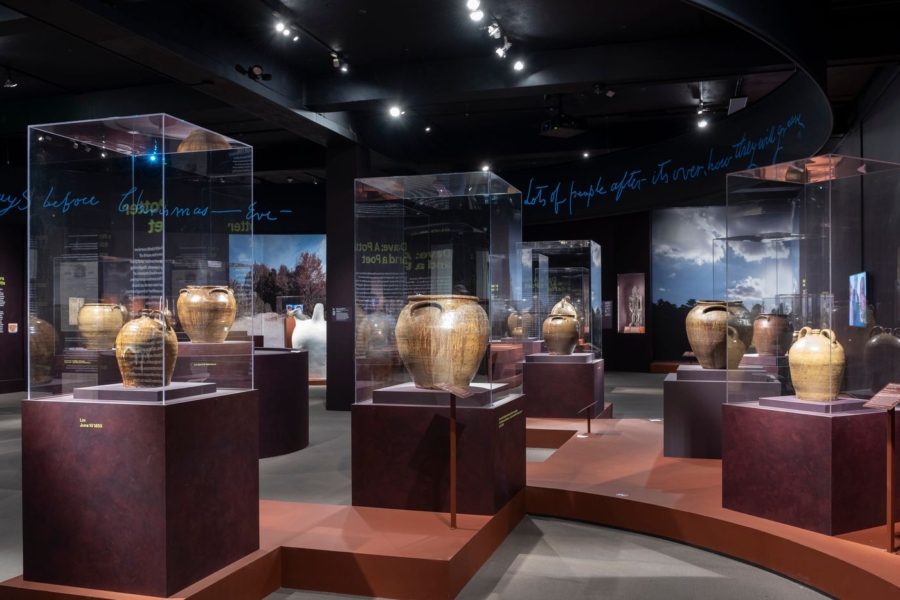May 10, 2023
Download as PDF
View on The Wall Street Journal

Installation view of ‘Here Me Now’ PHOTO: MUSEUM OF FINE ARTS, BOSTON
It’s edifying to see the same exhibition—reinterpreted, reinstalled—at more than one venue. I first saw “Hear Me Now: The Black Potters of Old Edgefield, South Carolina” at New York’s Metropolitan Museum of Art. The show combines historical ceramic vessels, sculpture and artifacts with contemporary ceramics, sculptures and drawings, mostly by black artists. Though fascinating and affecting, it felt like two exhibitions, at odds, rolled into one. When I re-experienced “Hear Me Now” at the Museum of Fine Arts, Boston, it was spacious, well-paced and integrated—a very different encounter.
At its heart are approximately 50 alkaline-glazed stoneware vessels: roughly 30 sizable jugs and storage jars (some adorned with painted garlands, figures, flora and fauna); and about 20 small, hand-modeled, high-relief-sculpted face-jugs. Many of these 19th-century vessels were created by enslaved artisans who participated in every aspect of their manufacture—mining clay, felling lumber, constructing kilns, making pots—in the numerous industrial potteries in Old Edgefield District, S.C. Most of the artists remain unrecorded. One of these gifted ceramists, David Drake (c. 1800-c. 1870), is now well known and featured here. A poet and master potter formerly known as “Dave,” “Dave the Potter” or “Dave the Slave,” he’s represented by a dozen large, lidless, stoneware jugs and storage jars, as well as some vessel fragments.
Drake’s heavy containers (some more than 2 feet tall, with capacities approaching 25 gallons) are impressive for their scale, brute physicality, rough-hewed beauty and sheer practicality. Barrel-chested, virtually neckless and enormously wide-mouthed, they are as squat as sumo wrestlers. Their thick, rolled-down lips are crude, wobbly. And many sport pairings of horizontal, crescent-moon- or ear-shaped handles on their broad shoulders. A few of Drake’s jars—including one, from 1834, roughly 20 inches tall—reach skyward and taper slenderly and gracefully to their feet. But most, firmly footed, suggest load-bearing columns. One monumental storage jar, from 1857, lists—as if struggling under the burden of its own mass.
These immense vessels (Drake produced thousands) were begun on the wheel and finished, with coils, by hand. They are bold, stout, grounded and earthen, not just in color and texture—a rich array of matte, satin, sandy and glossy browns, russets, creams, caramels and ochers—but in material, weight and utilitarianism. Spotted and streaked with dripped, running glazes, and with the snaking ridges of their coils rippling beneath their surfaces, they speak of mud and labor, usefulness and restlessness. They’re compelling because—like workhorses and folk art—though beautiful, they favor function.
Their utility extends to Drake’s wry poetry. Although literacy among enslaved people was criminalized and subject to corporal punishment, Drake signed, dated and incised verse on his pottery. On one jar, from 1858, he instructs: “This noble Jar = will hold, 20 / fill it with silver = then you’ll have plenty.” On another, Drake writes: “Good for lard—or holding—fresh meats = / blest we were—when peter saw the folded sheets / Lm may 3d 1859 / Dave” (“Lm” refers to Lewis Miles, the pottery studio owner). In Boston, Drake’s verse is projected overhead on a hanging circular screen.
Also extraordinary are the exhibition’s hand-held face-jugs, made by unrecorded artists. Their emergence coincides with the illegal arrival, in 1858, of a slave ship carrying more than 400 Africans, over 100 of whom were sent to Edgefield, where many became potters. These magical face-jugs, imbued with spiritual elements and symbols of African art, religion and culture, closely resemble minkisi, or ritual objects that, like Edgefield pottery, also contain kaolin. A rich, natural deposit available in both Edgefield and the Kongo kingdom, kaolin was sacred and medicinal to Africans, who employed it to facilitate communication between the living and the dead.
The face-jugs often have prominent, curving eyebrows and ears; bulging, spherical eyes; wide-open mouths with rows of bared, white teeth. Spouts rise from their crowns, and curving handles, like ponytails, jut from their posteriors. They look startled, powerful, comical or frightening. They display the singularity of jack-o’-lanterns and the guardian presence of gargoyles. A torn matchbook, attached to the interior shoulder of one face-jug (c. 1850-80), suggests it was used for ritualistic healing.
Welcome related works in “Hear Me Now” include an imposing, mixed-media, carved-wood Kongo power figure (c. 1850) that bristles, like a martyred St. Sebastian, with dozens of iron nails, spikes, shards and blades. Also appreciated are two earthenware vessels: a sublime “Bowl” (c. 1500), by an unrecorded Woodlands potter; and the gorgeous, veined “Cupid Jug” (2000), by Catawba Indian Nation potter Earl Robbins (1923-2010). MFA Boston edifies us further with an illustrated timeline, a section devoted to kaolin and video interviews with Drake’s descendants.
In New York, unfortunately, the 10 contemporary artworks (included, according to Met wall text, to address “our current moment of racial reckoning”) crowded the older works, making it seem like the Edgefield potters weren’t trusted enough to speak for themselves. Robert Pruitt’s large, illustrative drawings depicting staff members from Boston’s MFA handling face jugs came across as unnecessary, rather than incorporated and in dialogue as they are here; and most vessels, treated not as sculptures in the round, were displayed against walls. In Boston, everything is better.
“Hear Me Now” is co-curated by the Met’s Adrienne Spinozzi; Jason Young, of the University of Michigan; and Ethan Lasser, of MFA, Boston. It travels to Ann Arbor’s University of Michigan Museum of Art and Atlanta’s High Museum of Art. Let’s hope that future venues mimic not the Met but Boston’s installation, which underscores the power of presentation.



